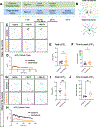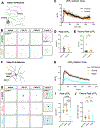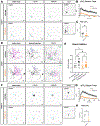Calcium plays an essential role in early-stage dendrite injury detection and regeneration
- PMID: 38825174
- PMCID: PMC11305834
- DOI: 10.1016/j.pneurobio.2024.102635
Calcium plays an essential role in early-stage dendrite injury detection and regeneration
Abstract
Dendrites are injured in a variety of clinical conditions such as traumatic brain and spinal cord injuries and stroke. How neurons detect injury directly to their dendrites to initiate a pro-regenerative response has not yet been thoroughly investigated. Calcium plays a critical role in the early stages of axonal injury detection and is also indispensable for regeneration of the severed axon. Here, we report cell and neurite type-specific differences in laser injury-induced elevations of intracellular calcium levels. Using a human KCNJ2 transgene, we demonstrate that hyperpolarizing neurons only at the time of injury dampens dendrite regeneration, suggesting that inhibition of injury-induced membrane depolarization (and thus early calcium influx) plays a role in detecting and responding to dendrite injury. In exploring potential downstream calcium-regulated effectors, we identify L-type voltage-gated calcium channels, inositol triphosphate signaling, and protein kinase D activity as drivers of dendrite regeneration. In conclusion, we demonstrate that dendrite injury-induced calcium elevations play a key role in the regenerative response of dendrites and begin to delineate the molecular mechanisms governing dendrite repair.
Keywords: Calcium; Dendrite injury; Dendrite regeneration; Dendrite repair; Drosophila; Injury detection.
Copyright © 2024 The Authors. Published by Elsevier Ltd.. All rights reserved.
Conflict of interest statement
Declaration of Competing Interest The authors declare that they have no known competing financial interests or personal relationships that could have appeared to influence the work reported in this paper.
Figures







Similar articles
-
Voltage-gated calcium channels act upstream of adenylyl cyclase Ac78C to promote timely initiation of dendrite regeneration.PLoS Genet. 2024 Aug 26;20(8):e1011388. doi: 10.1371/journal.pgen.1011388. eCollection 2024 Aug. PLoS Genet. 2024. PMID: 39186815 Free PMC article.
-
Dendrite injury triggers DLK-independent regeneration.Cell Rep. 2014 Jan 30;6(2):247-53. doi: 10.1016/j.celrep.2013.12.022. Epub 2014 Jan 9. Cell Rep. 2014. PMID: 24412365 Free PMC article.
-
Dendrite regeneration in the vertebrate spinal cord.Dev Biol. 2022 Aug;488:114-119. doi: 10.1016/j.ydbio.2022.05.014. Epub 2022 May 27. Dev Biol. 2022. PMID: 35644253 Free PMC article.
-
Out with the Old, In with the New: Dendrite Degeneration and Regeneration.In: Tran TS, Yaron A, editors. Wiring the Nervous System: Mechanisms of Axonal and Dendritic Remodelling in Health and Disease. 1st edition. Abingdon: River Publishers; 2024 Jan 31. Chapter 3. In: Tran TS, Yaron A, editors. Wiring the Nervous System: Mechanisms of Axonal and Dendritic Remodelling in Health and Disease. 1st edition. Abingdon: River Publishers; 2024 Jan 31. Chapter 3. PMID: 38536946 Free Books & Documents. Review.
-
Dendritic spikes and activity-dependent synaptic plasticity.Cell Tissue Res. 2006 Nov;326(2):369-77. doi: 10.1007/s00441-006-0263-8. Epub 2006 Jul 1. Cell Tissue Res. 2006. PMID: 16816965 Review.
Cited by
-
Voltage-gated calcium channels act upstream of adenylyl cyclase Ac78C to promote timely initiation of dendrite regeneration.PLoS Genet. 2024 Aug 26;20(8):e1011388. doi: 10.1371/journal.pgen.1011388. eCollection 2024 Aug. PLoS Genet. 2024. PMID: 39186815 Free PMC article.
References
-
- Berdan RC, Easaw JC, Wang R, 1993. Alterations in membrane potential after axotomy at different distances from the soma of an identified neuron and the effect of depolarization on neurite outgrowth and calcium channel expression. J. Neurophysiol. 69, 151–164. - PubMed
MeSH terms
Substances
Grants and funding
LinkOut - more resources
Full Text Sources
Molecular Biology Databases

